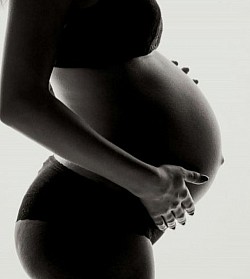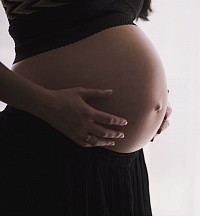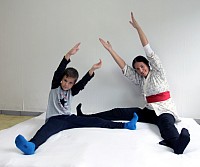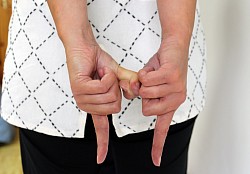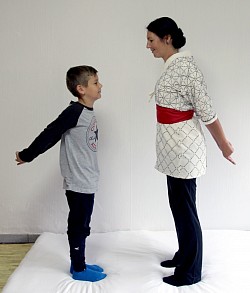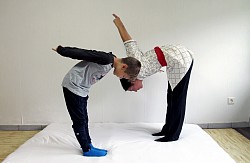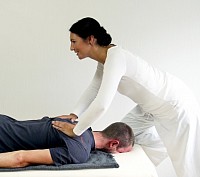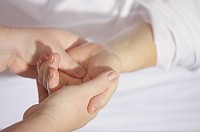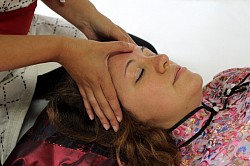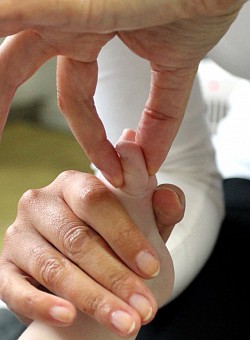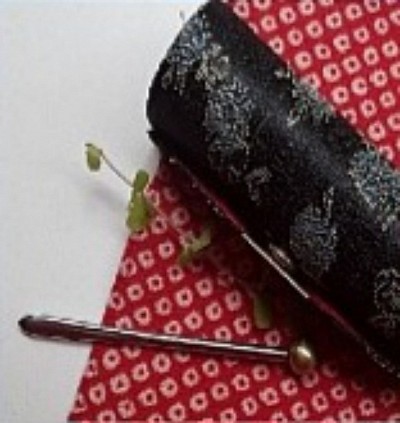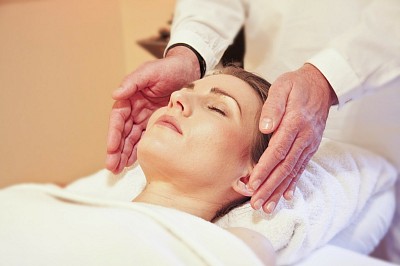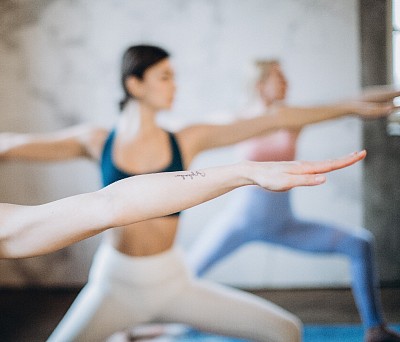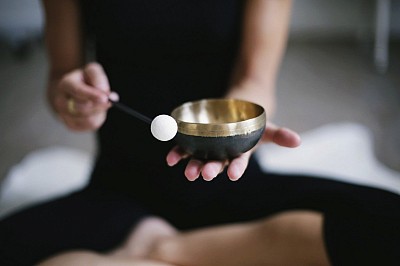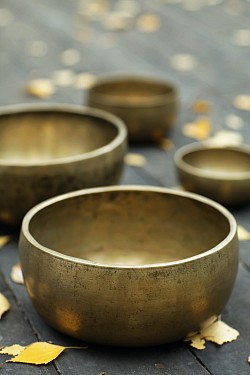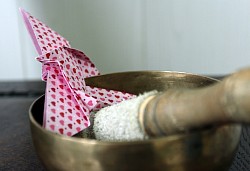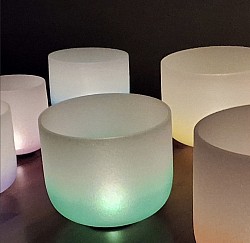FAQ: WHAT EXACTLY IS SHIATSU ... WHY DURING PREGNANCY ... WHAT ABOUT SHŌNISHIN ... ?
What is Shiatsu?
Literally taken Shiatsu means finger pressure (Jp. shi = finger, Jp. atsu = pressure). It is a holistic method, which is individually tailoured to the client's needs. Its Origin lies in Traditional Japanese Medicine (TJM).
Doing shiatsu, I use various techniques such as stretching, holding and kneading while applying body weight to different body areas along the meridians - the energy highways acupuncture also works with. In contrast to acupuncture, I don't use needles, but e.g. my hands and thumbs in order to harmonise the meridian system.
Shiatsu is performed through light and comfortable clothing.
Shiatsu involves various means of examination plus a great variety of possible forms of treatment - e.g. on the futon (a Japanese mattress), the massage chair, and - in addition - guided exercises (also to practice at home to support and intensify the effect of shiatsu treatment), shiatsu with words as well as tips and practical suggestions for everyday life.
When working with pregnant women,
I take special care of their individual condition, wishes and needs also considering the current trimester, physical as well as hormonal changes and imbalances which can lead to typical symptoms such as:
- nausea
- shortness of breath
- back pain.
Shiatsu strenghtens the bond of mother and child, bodily and emotional child development before birth the mother to better cope with typical symptoms and changes.
Furthermore, it is harmonising, relaxing, de-stressing.
The aim is, to help the client to maintain her/his inner balance, which can be challenging in our fast-moving time - often this so-called homeostasis gets disturbed. In this situation, shiatsu provides us with a great number of means to support and regulate our energetic system - relaxation and stress relief. Shiatsu encourages health promotion, sharpens our physical awareness and involves breathing techniques.
Why Shiatsu for children?
Working with children involves
- playing
- rhymes
- singing
- easy to learn techniques (self-efficacy)
...with older children and youths:
- more and more actual Shiatsu depending on the age and development stage of the child/youth.
Here, shiatsu smoothly and gently promotes emotional, sensory as well as body awareness and development appropriate to the child's individual needs and phase of development. It has regulating effects on digestion and emotional balance, promotes body awareness, perceptive as well as motor skills and straight posture, furthermore, it has positive effects on the relation between parent and child and e.g., the ability to concentrate.
For me personally, shiatsu means profound, deep touch!
... for youths?
Shiatsu in general is de-stressing, relaxes and promotes inner serenity, which is especially welcome when we have to adapt to constant bodily and hormonal changes while feeling exposed to an emotional roller coaster. During puberty, Shiatsu can be a chance to relax, find calmness and inner serenity.
So, Shiatsu is ideal to meet the needs of clients of all ages.
Please,
...wear light and comfortable clothing and warm socks for your treatment sessions and bring a big towel.
Thanks in advance!
Appointments on request.
What is ... the meaning of touch?
Touch is meaningful.
When a child falls or gets frightened, gentle stroking and a hug are enough to comfort and calm down the little one and the pain lessens.
The importance of touch has been subject of scientific research since the 1950s. Not each and every form of touch is pleasant and the source of well-being, of course. Gentle, slow and welcome stroking, however, the brain releases Oxytocin - a so-called "happy hormone" causing positive emotions.
Thefe is increasing evidence that the positive effect of bodily touch is of fundamental importance to the human being on various levels. Today it is obvious that touch such as described above has positive effects. It is supportive - to premature babies, who drink better when touched regularly, to those who are ill, who get well sooner when there is someone to hold their hand, for the athlete who pats his comrade on the shoulder, encouragingly, ...
Touch promotes comfort and well-being. It makes us less suscepti le to stress and fear. It promotes healthy baby and child development. It influences the development of intelligence. It supports short term memory and helps with thinking - especially with maths. It strenthens our immune system as well as our circulation. It impacts our social behaviour - impacts our capacity for bonding, teamwork and potential or contributes - when missing - to avgressive behaviour.
Which kind of touch we experience in the course of our lives determines our health and social behaviour.
All of these are good reasons for me
to touch others with my work!
What is Shōnishin?
Shōnishin - The Non-invasive Art of Japanese Acupuncture.
Shōnishin (Jp. shōni – child; Jp. shin – needle/needling) is a soothing, de-stressing and non-invasive method. It is unique, and highly effective.
It was developed in Japan especially for treating children more than 250 years ago, as the kids feared traditional Chinese needling. So, the Japanese Acupuncturists came up with a simple solution: They developed a unique metal instrument and refined the technique, making it possible to treat Acupuncture points avoiding "the sting".
In doing Shōnishin, the pencil-like instrument, is used on the skin directly in various techniques such as stroking, tapping, and vibration. The treatment deeply affects the acupuncture points (Tsubos) of the meridian system while increasing the body's oxytocin levels.
Usually, the client is lying on a futon or a massage table during the session.
The instrument does not actually pierce the skin as it is done in classical Chinese Acupuncture, therefore, the method is perfect for treating those afraid of needles as well as children.
Regarding my work, I promote a holistic approach taking into account the individual motoric, sensory, and emotional state, as well as the energetic level of development of my clients, in order to meet their individual needs.
What is ... Reiki?
The term "Reiki" means something like "universal (rei) life energy (ki)" literally. It is a Japanese method aiming at harmonising the body's energy in order to promote inner balance (homeostasis) - touching the body or even without touch.
During the treatment, the client is resting on the futon - the Japanese mattress - while the practitioner performs Reiki on the clothed body. Reiki has calming, relaxing, and de-stressing effects.
The method was developed by Mikao Usui (1865-1926), at the beginning of the 20th C. Even though the method is comparatively new, the term "Reiki" has been used in sanscrit scripture dating back 2500 years.
What is ... Qi gong?
Qi gong has its origins in China. "Qi" means "breath, energy, life force" and "gong" "work, capacity, proficiency." - According to Eastern understanding, it means constantly practicing one's life energy, or refers to the capacity of using one's life force adequately.
The exercises aim at balancing the life force of the body's meridians (vessels) to allow the life energy to flow freely and unhindered throughout the body to where it is needed to react to life's challenges adequately. Qi gong combines breath -, movement -, and meditation exercises, performed concentrated, slowly, and in gentle flowing motion.
Performing Qi gong regularly has many advantages:
it is de-stressing promotes well-being stregthens the ability to concentrate deepens breathing strengthens and regulates nervous and immune system, circulation, lymph flow, as well as muscular system mobilises and, therefore, supports flexibility supports straight posture trains body awareness strengthens self-regulation ability promotes capability of concentration promotes emotional balance harmonises body and mind easy on the joints, due to slow and controlled way of motion.
Qi gong can be performed by people of all ages, because of the gentle, controlled way of movement taking into consideration the performer's constitution with respect to all individual needs.
The practice dates back as far as the "Huangdi Neijin" ("The Yellow Emperor's Inner Classic") - the standard reference of Traditional Chinese Medicine (TCM) - which was written about 200 CE. The term referring to a series of corresponding exercises used here is "healing force", Dao Yin. Another testimony for the practice are the Mawangdui Silk Texts including 44 depictions of exercises performed standing, and sitting.
The term "Qi gong" used today, however, was coined during the 1950s by the doctor Liu Guizhen.
What does ... sound experience mean ... how does it work?
Sound influences our emotions and our psychy, which doesn't come by chance. Every body - whether sound or human body - has its unique vibe. This is also true for the brain, which vibrates on a special wavelength depending on the state of conciousness:
beta waves, when awake alpha waves, when at rest or during meditation theta waves, when falling asleep, and delta waves during deep sleep.
When an instrument sounds near to us the vibe is transferred from the instrument to the body - not only via ear, but also from cell to cell. This is possible as the body consist up to about 75% of water and its bone structure functions like an antenna. So, the harmonious sound of the instrument oscillating in alpha / teta waves reverberates within the body causing the brain and body to go into quiet meditative mode which leads to relaxation. This effects intensifies when relaxing via sound on a regular basis, due to the experience.
Therefore, it is possible, for example, to introduce a basic level of relaxation by beginning a Shiatsu or Qi gong session with a sound meditation, which adds to the effect of the treatment and the moving meditation respectively, because the body prepares for the experience and is therefore more prone to respond to the treatment/exercise leading to the ki - life energy - to flow more freely and unhindered within the body:
The body reaches a state of rest in advance. This leads to a state of de-stress and the body can relax more easily. Tensions can dissolve. Emotional blockages can regulate.
I work with:
koshi chimes singing bowls and kalimba ...
